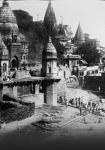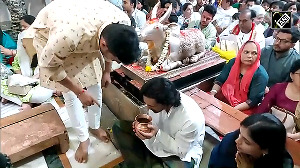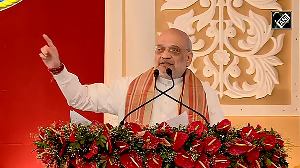An unbeaten 134 by Rahul Dravid and handsome contributions from Parthiv Patel (69), VVS Laxman (71) and Sourav Ganguly (53 not out) put India in a strong position at close on day 2 in the third Test against Pakistan in Rawalpindi on Wednesday.
When stumps were drawn for the day, India were 342 for 4 in their first innings, a lead of 118 runs.
Shoaib Akhtar claimed two of the three wickets to fall on day 2 for figures of 3 for 47.
Morning session
Patel and Dravid looked to consolidate early. They knew that they needed to bat well for the other batsmen, like Sachin Tendulkar, Yuvraj Singh and Sourav Ganguly, to make things really difficult for the Pakistanis. And that's exactly what they did. Both batted with restraint in the first hour, as a result of which the first fifty runs of the Indian innings came off 141 balls.
The going was slow, so slow that after 20 overs India had reached only 30, at a run-rate of 1.54. With Virender Sehwag at the top of the order India had got used to quick if not blistering starts.
Parthiv has averaged 72.00 in 2004 and on evidence of his current form that average could only increase. But the Indians should not make the mistake of drafting him as a regular opener. One swallow does not make a spring. In much the same manner one good knock does not make him an opener.
Dravid, on 21, survived the only real chance of the morning session. The ball would have crashed into his stumps, but Sami was denied success by the umpire. Relived of the pressures of captaincy, Dravid showed some signs of returning to form as the tour winds to a close.
One striking feature throughout the Test series has been the inability of the Pakistan bowlers to get any kind of reverse swing. There was a time in the eighties and nineties when the likes of Imran Khan, Sarfaraz Nawaz, Wasim Akram, Waqar Younis and Aaquib Javed could get the ball to reverse swing as early as the 20th over. But now, not even Shoaib Akhtar is able to get the ball to do so. That is in stark comparison to the Indian bowlers who made the ball swing throughout the innings.
The second fifty off the Indian innings came in only 71 balls, much faster than the first. It was also a clear indication that the batsmen were over the initial nerves and starting to play their shots. Patel reached his highest Test score, 65, during the session. In the process, he registered his third fifty this year.
Dravid was on 46, looking all set to grind the Pakistan attack on a pitch that seems to be getting better for batting with every passing second.
India scored 96 runs in the 28-over session at a run-rate of 3.43 to reach 119 for the loss of one wicket. They are just 105 runs behind Pakistan's first innings total and firmly in command. But the thing about Test matches is that one good session can change the scenario. Pakistan will be hoping Akhtar and Sami can bring about that change.
Parthiv Patel was unbeaten on 65, his highest Test score, and Rahul Dravid on 46 at the break as India reached 119 for the loss of one wicket.
Post-lunch session
The match did not proceed as desired for India after lunch. Almost immediately after the break Patel was heading back to the pavilion. The left-handed batsman's concentration seemed to waver a bit in Fazl-e-Akbar's 47th over when he was dropped in the gully by Imran Farhat. It was a tough chance, but the fielder was on his heels and slow to react.
But Fazl finally got the breakthrough Pakistan were looking for all morning. In the 49th over, he slanted one across Patel and the resultant edge flew straight to the keeper. There was no need to play that shot and Patel paid the price. (129-2). He scored a career-best 69 and put on 129 runs for the second wicket with Dravid.
Rahul Dravid reached his 33rd Test fifty with a four through the point region. It was not his typical innings; there were a lot of runs scored through edges and snicks and it reminded one that the master batsman had scored at an average of only 17.00 before this knock.
Exactly six balls after Patel was out, Akhtar struck a big blow when he sent Sachin Tendulkar back to the hut after scoring just one. A short delivery on the off-stump forced Tendulkar to fend at it. Wicket-keeper Akmal made no mistake and Tendulkar walked even without waiting for the umpire to give his decision.
This heralded an edgy period of play for India. The Pakistanis were buoyed by the two quick wickets, but Dravid and new man in V V S Laxman were determined to keep them at bay.
Dravid just shut shop, making it clear that he intended to be there at the end of the session. He defended resolutely and at the tea break had scored 84 runs off 220 balls, at a strike rate of just 38.18.
Laxman, at the other end, after facing torrid spell of short-pitched fast bowling from Akhtar got into his stride and stroked the ball with authority through the covers to reach 36 off 56 balls at the break.
India scored 84 runs in 27 overs for the loss of two wickets during the session. At tea, they were 203 for the loss three wickets.
Post-tea session
Laxman shifted into top gear immediately after the break. His first 33 runs after tea came off just 22 balls, with seven fours. It provided a clear indication of the manner in which he attacked the Pakistan bowlers. A cover driven four was followed by a brilliant pull. Fazl bore the brunt of his assault. Of the 23 balls the right-hander faced, he hammered 35 runs and, in the process, forced Inzamam-ul Haq to take the bowler out of the attack.
A measure of the way the tempo of the innings changed can be observed in the scores progression: from 100 to 150 India needed 112 deliveries; the next fifty came off 91 balls and the final 50 off just 55 balls as India reached 250.
Laxman scored at such a quick pace that for a while it seemed as if he would overtake Dravid. He certainly gave the Indian innings the impetus it so badly needed.
The danger with scoring runs very slowly is that a few quick wickets can put the team into trouble very quickly when not many runs are on the board. In the morning session India ran that risk, but once Laxman got into his stride the scenario changed.
Dravid, at the other end, reached his 17th Test century -- his 11th away from home. He is one of the few top-order batsmen who average higher away (61.00) than at home (51.00).
Assistant editor Faisal Shariff, who is in Rawalpindi, had told me earlier in the day that Dravid left the dining table early yesterday telling his team mates, "I have a full day's batting ahead of me."
The bowlers were tiring and even though Akhtar had kept Dravid on a tight leash, the others did not give him adequate support. Pakistan were now looking to the new ball to get them the elusive breakthrough and Inzamam took Akhtar out the attack.
But the fast bowler was back as soon as the new ball was taken in the 82nd over. The first ball whizzed past Dravid's bat. The next one hit the bat high on the splice.
Seeing that his top bowler was all charged up, Inzamam put in another slip. It was three slips and a gully for Dravid. And as Akhtar continued to steam in, it was expected that something would happen. And it did.
In the 84th over, Akhtar got Laxman's wicket. A speedy full-toss on the middle stump moved very late to beat Laxman's bat and shatter his castle. Laxman's expression at his dismissal was one of disbelief. He looked up as if to say, `Hey, the ball is not supposed to do that in the air.' A promising innings nipped in the bud.
But he had scored 71 runs from only 99 balls, which included 12 fours, and added 131 runs with Dravid.
Akhtar had bowled brilliantly but could send down only one more over in the session. In the next over he fell down while following through and injured his left wrist. He did not bowl again even though he came on to field.
Sourav Ganguly joined Dravid at the wicket and things progressed smoothly. Dravid held his end up while Ganguly played a few shots. The duo batted with ease to push the lead to 118 runs by the end of the day.
Ganguly reached his fifty, his third against Pakistan, off the last ball of the day to finish the day on 53 off 72 balls. Dravid was still there, as steady as a rock, on 134.
After tea, India put on 139 runs in 35 overs for the loss of one wicket. They are firmly in command and even though the pitch is very good for batting right now, it could be different on the last two days.
The main point of interest tomorrow is how well India utilizes the advantage of this strong platform.







 © 2025
© 2025